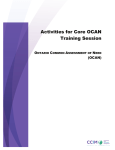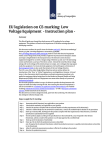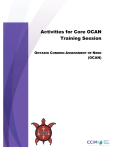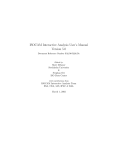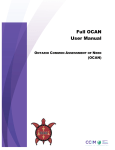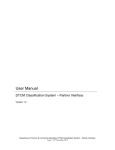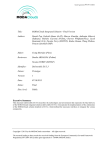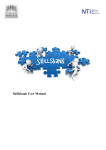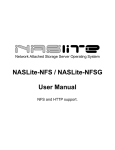Download Tab 2b - Presentation with notes DAY 2
Transcript
OCAN Education Training for OCAN Users Day 2 Intent: The intent of this slide is to: -Invite participants to day two of training -review ground rules -review parking lot issues 1 Objectives Learn how to: • Complete staff assessment • Interpret and make use of information from OCAN in a number of ways • Introduce assessment, re-assessment guidelines • Introduce OCAN into business process in your health service provider (HSP) organization Intent: The intent of this slide is to review the objectives that were introduced in Day 1. Reference: User Manual will provide these objectives Notes: -Review the objectives -Introduce HSP organization-specific objectives 2 OCAN Training Agenda - Day 2 • Welcome & Introductions • Objectives • Unit 2 – OCAN Assessment Process (cont’d) – Staff Assessment – Scoring Activity • Unit 3 – Outputs-Actions, Referrals, Reports • Unit 4 – Timelines and Reassessment • Unit 5 – Business Process • Next Steps • Evaluations 3 Intent: This slide gives you the opportunity to review the Day 2 Training Agenda – this slide is optional if you are training in-house in other formats, i.e., breaking up the units of instruction. Notes: In addition to reviewing the agenda, you may want to keep track of questions and issues on a flipchart labelled “Parking Lot” as they come up. Lunches and breaks will happen at regular intervals and where they’re appropriate. We envision lunch around noon with a morning and afternoon break. Reminder of evaluation at end of day. 3 Unit 2 Continued Staff Assessment Intent: This slide allows you to introduce the continuation of Unit 2 – you may want to refer participants to the correct page number in the Manual at the beginning of each unit. 4 OCAN Staff Assessment Score Need Score Help 5 Intent: To highlight the components of the staff assessment doc. Reference: User Binder Tab 2 Tools User Binder Tab 7 Appendices C & D – will be using Domains Documents mostly on Day 2 Notes: Have participants look at tool in Binder Tab 2 Show all the components of staff assessment and how it differs from self-assessment 1. Score need 2. Score formal and informal help 3. Comments 4. Actions 5. Additional data element questions in 12 domains Debrief Any questions? “Using OCAN enabled me to ask questions that I’d never considered asking before. It was helpful for the consumer to open up and have these conversations.” Direct service worker, after using OCAN 5 OCAN Staff Assessment Key Points • In each of the 24 domains, the staff is determining and recording the scores for need and help • For every met or unmet need, the help score must be completed • If there is no identified need, a help rating is not required, but the extra questions in the domain should be completed • Action and comments fields should be completed as robustly as possible when indicated • Information gathered is important to inform the ongoing work with the consumer and is reflected in reports 6 Intent: The intent of this slide is to review key points about the Staff Assessment Notes: Purpose of Staff Assessment is to gather information on need and help. Help is optional to document, and only required if a met or unmet need is scored. In domains where there is an unknown need or a no need, staff may move on to the next domain except where there are additional questions to be answered in the domain, as applicable. Comments and actions fields are useful tools. All information helps to inform the ongoing work with the consumer, can be reflected in reports 6 OCAN Staff Assessment Key Points cont’d Many reasons can cause an increase in consumeridentified unmet needs from assessment to reassessment including: • consumer’s perceived decline in these areas • consumer’s journey of recovery allows them to identify different or new unmet needs as their horizons expand 7 Intent: The intent of this slide is to reinforce that the intent is not to expect to always see a reduction in needs from one assessment to another. Notes: Some things to consider as you complete the staff assessment are: An increase in consumer-identified unmet needs can be due to two possible factors: consumer’s perceived decline in these areas or consumer’s journey of recovery allows them to identify different or new unmet needs as their horizons expand With regard to variances, differences of opinion are natural and beneficial. If agreement was perfect the multiple perspectives would be redundant. So striving for perfect agreement is unrealistic. It’s Part 2 – the staff assessment is one very important part of the whole and it’s a summary of the assessment conversation, the collateral information and your clinical judgment Mobility – the OCAN may be used to provide information to services that the person is referred to – ensure that the information is comprehensive enough to be of use and appropriate to the service the referral offers 7 OCAN Staff Assessment Key Points cont’d Need in Relation to Help 0 = No Need (No serious problem) 1 = Met need (No/moderate problem due to help) 2 = Unmet need (Serious problem) 9 = Not known 8 Intent: The intent of this slide is to introduce the concept of need ratings in relation to help ratings. Help can assist in determining how need is rated. Notes: When we talk about “no need” we’re referring to the notion of “independence” which means that help is not provided. When we talk about “met need” we assume that help is provided, either formal or informal, to meet the need. When we talk about an “unmet need” or “serious problem” help may or may not be provided 8 Pop Quiz! 1. 2. 3. 4. What does OCAN stand for? What are the 4 steps of OCAN? Who can help complete the Self-Assessment? What if a Consumer does not wish to complete a Self-Assessment? 5. If informal or formal help is scored as 3, what does that mean? 6. If a score of 1 is given for need, what could that mean? 9 Intent: The intent of this slide is to review, in a fun way, information learned in the previous day / or previous lessons Notes: Answer Key 1. Ontario Common Assessment of Need 2. Introduction, Consumer Self-Assessment, Conversation, Staff Assessment 3. Anyone, with the assistance of the Helping a Consumer one-page document 4. That’s ok. It won’t impact on someone’s acceptance to service. 5. It means that the help is frequent and that it is effective. 6. It means that the consumer has no need or moderate need based on the help s/he is receiving by informal and/or formal supports. It means that if that help was removed today, the consumer may likely have a need in that particular domain. Debrief Questions: - Did you find this review helpful? - Did you find the questions too easy / hard? - How did you do? Do you feel you need more review? - Are you ready to begin a case study? Practice: Scoring OCAN Practice Module includes: • Consumer Self-Assessment • Consumer Conversation • OCAN staff assessment with collateral information 10 Intent: The intent of this slide is to introduce the Mike and Lorraine Case Study Reference: Activity for Participants under the “Activities” Tab of the User Binder Instructions for facilitating case study and answer key located in the Activities tab of the Coordinator Binder Notes: Divide group into sub-groups of three or four Ensure roles are assigned and ask “Mike and Lorraine” to read each part aloud. Provide start and end times for activity Circulate to provide feedback Debrief Questions: Encourage questions prior to exercise beginning Practice Debrief: How can you use a recovery focus to talk about variances (differences) between the consumer selfassessment and the worker assessment? How do you dialogue about successes when the consumer has indicated that there is “no need”? How can you use a recovery focus to talk about unmet needs that both you and the consumer identify? 10 Unit 3 Outputs Intent: This slide allows you to introduce Unit 3 – you may want to refer participants to the correct page number in the Manual at the beginning of each unit. Notes: The outputs that will be described in this unit are: Summary of Actions Summary of Referrals Individual Assessment Reports 11 Summary of Actions • At the end of the assessment, actions will be summarized in a table that looks like the following: Priority Domain 1 Accommodation Action Submit application for supported housing 12 Intent: This slide introduces the concept of the Summary of Actions Notes: Actions will be pulled from where they are entered in the staff automated assessment and populated with the corresponding domain. At the end of the assessment, the consumer and staff will determine the priority for each action. This table forms one of the elements of the “Summary of Actions and Referrals Report” that will be reviewed in this section Priorities need to be entered manually; there should be a priority for every action Debrief Questions: -Can you see how you might use this summary with a consumer? 12 Summary of Referrals • At the end of the assessment referrals and status of the referral can be documented in this chart • This working tool is helpful to track referrals on an ongoing basis • An outcome of the Summary of Referrals is the identification of gaps in service Optimal Referral Specify Actual Referral Specify Reason for Difference Status of Referral Drop down list Name of optimal referral Drop down list Name of actual referral Drop down list Drop down list 13 Intent: This slide introduces the concept of the Summary of Referrals Notes: The Summary of Referrals is both an input into the assessment as well as an output. The intent of the Summary of Referrals is to: •provide clinicians with one place to consistently document referrals and their status •to document the gaps between the services available and the services that would be optimal to meet a person’s needs. Documentation starts during the assessment period (30 days) and continues at the next assessment “Reason for Difference” Choices: Service does not exist Service not available locally Service not available due to language issues Service not available due to financial issues Service not available due to physical barriers – physical, vision, hearing Exclusionary criteria Excessive wait times for service Wait list closed Need exists but service not identified by client/staff Service available but only partially meets client’s need “Status of Referral Choices”: Received Accepted onto waitlist Rejected Withdrawn (by the client) Accepted into service At reassessment, clinicians will review status of all completed and outstanding referrals since the last OCAN was completed. These will be documented in the Summary of Referrals for the current assessment. Debrief Questions: Can you see how there might be benefits to keeping track of referrals between OCAN assessments? 13 Individual Assessment Reports 1. Individual Need Rating Over Time 2. Needs Over Time 3. Summary of Actions and Comments 4. Staff Workload 14 Intent: This slide allows you to introduce the individual Assessment Reports. Reference: Sample reports in “Outputs” tab Notes: Uses of Information and Outcomes OCAN can provide information at many levels for individual users, HSP organizations, LHINs and the sector. Examples of individual uses of OCAN information are: gathers pertinent information to inform the service plan including referrals both internal and external and informs the reports as depicted in the mock-ups Examples of HSP organization use of OCAN information is: statistical information on populations served and identification of gaps in service in community Examples of sector use of OCAN information are: identification of gaps, statistical information on populations served and resource allocation Reports: 1. Shows overall change in needs comparing consumer to staff. May be easy for consumer to understand. 2. Show change over time in specific need rating for individual consumer –consumer and staff perspective 3. Lists all actions and comments associated to assessments and domains chosen by staff to be displayed 4. Lists status of open assessments assigned to individual staff and timeframe for re-assessment Debrief Questions: - In what ways would you be able to use the information from the Individual Assessment Reports? - In what ways could you make the information valuable and pertinent to the consumer you’re working with? 14 Unit 4 Timelines and Reassessment Intent: This slide allows you to introduce Unit 4 – you may want to refer participants to the correct page number in the Manual at the beginning of each unit. Notes: Unit 4 is a large unit that describes not only reassessment but introduces participants to the following topics: -Timelines for Assessment -Types of Assessment 15 Reassessment What is reassessment? • a structured, documented review using OCAN • an opportunity for consumers and providers to regularly review needs, identify accomplishments and inform next steps • consists of the consumers self assessment, the staff assessment and information from other sources e.g. providers and family members 16 Intent: This intent of this slide is to introduce the concept of reassessment. Notes: -Assessment precedes reassessment -Provides an opportunity for consumers and providers to review -Consists of the completion of a complete OCAN 16 Assessment on a ‘Heartbeat’ Initiating the “Heartbeat” Start Date End Date Start Date End Date Assessment 1 May 1 Assessment 1 May 30 Assessment 2 November 1 Assessment 2 November 30 30 Days Max 30 Days Max 6 M O N T H S Once the start date is chosen, the end date is 30 days from the start date. The next assessment happens 6 months from the start date of the previous assessment. Sustaining the “Heartbeat” Assessment 1 May 1 2008 Reassessment 1 at 6 months November 1 2008 Reassessment 2 at 12 months May 1 2009 Significant Change or other assessment Reassessment 3 at 18 months November 1 2009 Consumer requested assessment Regardless of any assessment completed between the “heartbeats”, the assessments continue every 6 months. 17 Intent: This slide illustrates how we initiate the OCAN Assessment “Heartbeat” and how we sustain it. Notes: OCAN is completed every 6 months. This is referred to as the “heartbeat.” This assessment type is chosen for consumers who have completed a prior OCAN or are existing consumers for whom this will be the first OCAN. Sustaining the “heartbeat” is key to the success of reassessment. Review the two illustrations and ask for any questions. OCAN remains open for 30 days from start date to completion date. OCAN marked as “complete” after 30 days – can no longer be edited. 30-Day Window – the Assessment Completion Period: The assessment start date and completion date should be within 30 days of each other. The start date of the assessment in the system is whichever is started first: the consumer Self-Assessment or the Staff Assessment. The completion date of the assessment in the system is whichever is finished last, provided that both Self-Assessment and Staff Assessment have been started and completed within 30 days. For example, when a consumer Self-Assessment start date is entered first, the Staff Assessment must be completed by day 30, even if the Staff Assessment was not started until day 15. If the consumer Self-Assessment is not completed within 30 days, then the Staff Assessment completion date is entered in the system before the end of the assessment completion period. Hints: collateral information that arrives after the 30 days can be recorded elsewhere ongoing discussion and progress with consumer is documented in regular progress notes referrals made after 30 days are recorded in notes for inclusion in the next OCAN in the Summary of Referrals Scenarios: Something major happens to the consumer between 30 days and 6 months. in this case, you may want to complete the OCAN to capture any additional needs and interventions that are required at this time. Choose assessment type “significant change.” My collateral information has arrived and I’ve completed the assessment. add the information to the progress notes and document as appropriate in the next OCAN notify the other members of the circle of care as appropriate I’ve made referrals between assessments – where and when do I document this in the OCAN? referrals and updates to referral status are recorded between assessment in progress notes and added to the OCAN document in the Summary of Referrals at every reassessment. The consumer I work with has identified the need for another assessment before their reassessment. an OCAN will be completed at the request of the consumer or at the discretion of the clinician 17 Assessment on a ‘Heartbeat’ Resetting the “Heartbeat” Assessment 1 Core Ax or Core + Self Ax May 1 2008 Reassessment 1 at 6 months November 1 2008 Other Assessment 1 November 15, 2008 Referral to another health service provider that completes a Full OCAN Heartbeat is Reset 6 M O N T H S 15 DAY GAP 6 Reassessment 1 May 15, 2009 6 month heartbeat continues to accommodate Full OCAN schedule M O N T H S 6 Reassessment 2 November 15, 2009 6 month heartbeat continues to accommodate Full OCAN schedule M O N T H S The heartbeat is reset when service begins with a Health Service Provider that completes a Full OCAN – also known as the fullest dataset. Intent: This slide illustrates a future state that shows a scenario where, as services change, so may the heartbeat. You may choose to skip over this slide or give it a very light touch as it does not apply at this time. Notes: In this scenario we see a Core or Core + Self first and reassessment completed – the client is transferred to an agency that becomes the OCAN lead that completes a more fullsome dataset – the Full OCAN so in this scenario the heartbeat resets based on the first assessment completed by the new Lead. 18 Types of Assessment • Assessment types are chosen in OCAN and include: – – – – – – – Initial OCAN Reassessment (Prior to) Discharge Significant Change Review Re-key Other 19 Intent: This intent of this slide is to introduce the different types of OCAN assessment that can be chosen. Notes: -Briefly review the 7 types of assessment -Review and re-key do not apply at this time. Initial OCAN • An “Initial OCAN” is only completed by the OCAN Lead when the person participating is new to the Community Mental Health system or is re-entering the Community Mental Health system more than 90 days after a previous discharge. 20 Intent: This intent of this slide is to introduce the “Initial OCAN” type Notes: -Review the definition for this assessment. -Reinforce that the initial assessment should only be ticked off if the consumer is new to the mental health system or if it has been more than 90 days (3 months) since a discharge assessment was completed. If this is not the case, then you would tick off Reassessment. Reassessment • OCAN is completed every 6 months. • This is referred to as the “heartbeat” • The “Reassessment” is chosen for clients who have completed a prior OCAN or they are existing clients for whom this will be their first OCAN • Completed by the OCAN lead 21 Intent: This intent of this slide is to introduce the “Reassessment” type Notes: -Review the definition for this assessment. -Reinforce that existing clients who have not had OCAN before will fall into this category (Prior to) Discharge • Discharge for the purposes of OCAN is planned discharge from the mental health system. This assessment type is completed by the OCAN Lead. For details, please refer to the guidelines below: • (Prior to) discharge – REQUIRED • Client is leaving the Community Mental Health System (planned discharge) • (Prior to) discharge – NOT REQUIRED • Client “drops out” of Community Mental Health Services (unplanned) • Transfer of a client from one Community Mental Health program / HSP organization to another* 22 Intent: This intent of this slide is to introduce the “(Prior to) Discharge” type Notes: -This type of assessment is completed by the OCAN Lead -Review the definition for this assessment. -Reinforce when it’s required to record this type and when it’s not required -The discharge assessment should only be completed if the provider is not aware of any other services that the consumer is involved with within the ONTARIO community mental health system. - Providers may not know all of the consumers involvement with the system, so the message is that you make decisions as to the “reason for assessment” based on the rules and what you are aware of. -Regarding exit from a specific service, please ensure that you are telling providers to record the “exit disposition” for CDS the way they currently do – and in the Service Use Record. Significant Change • A Significant Change OCAN does not change the “heartbeat” • It is completed by the OCAN Lead • OCAN can also be completed when there is a significant change in the person’s life that may require closer assessment to ensure that the most current needs are identified 23 Intent: This intent of this slide is to introduce the “Significant Change” type Notes: -Review the definition for this assessment. -Provide definitions of Significant Change -Consider providing a scenario of when you may or may not choose to complete a significant change Review • A Review OCAN does not change the “heartbeat.” It is conducted when an HSP organization receives an OCAN from another HSP organization and updates fields to reflect the current consumer situation when they enter it into their own system. • Important: When entering a Review OCAN into the system, the start and end dates should be the dates that the “Review” was entered in your system and not the start and end dates of the original assessment. 24 Intent: This intent of this slide is to preview a future type of assessment -- the “Review” type Notes: -Typically a review OCAN is completed by a contributing provider, although when leadership is transferred, a lead may also complete a review OCAN. -Review the definition for Review OCAN (HSP A sends an updated OCAN, HSP B updates those fields and enters as a review) -Consider providing a scenario of when you may or may not choose to complete a Review OCAN -Please indicate that this will not be a selection that assessors will be required to make at this time as it supports the future potential use of OCAN with multiple service providers Re-key • A Re-key OCAN may or may not be completed by the OCAN Lead and it does not change the “heartbeat” • Re-key OCAN is conducted when an HSP organization receives an OCAN from another HSP organization and does not update any of the fields when they enter it into their own system • HSP organizations may choose to re-key when a paper copy is not needed 25 Intent: This intent of this slide is to preview a future type of assessment -- the “Rekey” type Notes: -Typically a rekey OCAN is completed by a contributing service provider, although when leadership is transferred, a lead may also complete a rekey OCAN. -Review the definition for Re-key OCAN -Consider providing a scenario of when you may or may not choose to complete a Re-Key OCAN -Please indicate that this will not be a selection that assessors will be required to make at this time as it supports the future potential use of OCAN with multiple service providers Other • An “Other” OCAN does not change the ‘heartbeat’ • An example of an other reason for assessment could be ‘consumer request’ • For any “Other” reason for assessment, the staff person records the reason 26 Intent: This intent of this slide is to introduce the “Other” type Notes: -Review the definition for Other OCAN -Consider providing a scenario of when you may or may not choose to complete an Other OCAN For correct and consistent administration, it’s very important to review the details of these types of assessments in the manual beginning on page 41. Unit 5 Business Process Intent: This slide allows you to introduce Unit 5 – you may want to refer participants to the correct page number in the Manual at the beginning of each unit. 27 Business Process What is an HSP organization Business Process? • A series of connected steps / actions / tasks to achieve an outcome • It is what you do in your HSP from the time a consumer enters your HSP up to planning services for him\her • Business Process Mapping is a diagram showing how work flows through your HSP 28 Intent: This intent of this slide is to describe what a business process is and how a business process map can show how work flows through your HSP organization. Notes: Review definition of business process. Review generic business process maps in appendix Compare and contrast with your HSP organization’s business processes 28 Business Process INTAKE ORIENTATION TO HSP ORG ACCEPTANCE TO SERVICE SERVICE PLANNING • Where does OCAN fit? • What can it replace? 29 Intent: This slide is intended to show where OCAN might fit within the processes that you already do and to suggest that it may be able to replace assessments currently done. Notes: Think of OCAN as if it were a building block that helps you do the work that you need to do with the people that your agency serves. As an important building block you should ask yourself, “where does it fit best in what we need to do?” Every HSP organization will need to determine this for itself and this may even extend down to the program level. OCAN may be used at different stages within the assessment process as illustrated below. When implementing OCAN, an HSP organization may choose to change some of its business process to avoid duplication of work. 29 Business Process Think about how your HSP will use OCAN in your current business process. Questions:? Will OCAN replace part of current assessment? Will OCAN replace current assessment? Will OCAN be added to current assessment? 30 Intent: This intent of this slide is to generate discussion around your business process. Notes: Lead the group in a discussion around these questions and record answers. OR Break the group into smaller groups to have a discussion around these questions, debrief and record answers. 30 Available Resources & Supports Resources • Your Change Team • OCAN Implementation Guide • OCAN 2-day training user binder • Co-ordinator training binder • Quick reference guides • Consumer support materials Supports • Portal(s) • Project Support Centre – ([email protected]) • OCAN Knowledge (OK) Café • IT services 31 Intent: This slide illustrates the support available to staff implementing OCAN. This includes people and processes (such as escalation processes). Notes: Review and describe any internal contacts that may be useful to the training participants. Also describe any processes in place to ensure effective change management and communications. Debrief Questions: 31 Please don’t forget your evaluation! Intent: To find out how participants are feeling. How did the day go? Are there other questions coming up as they went along? Notes: Starting time for the next day. Ask for questions. General review of day. Remember: Review the objectives that participants identified at the beginning of Day 1 and ensure they were covered. Review parking lot issues and set expectations around when participants can expect to hear back. 32 Thank You! 33


































